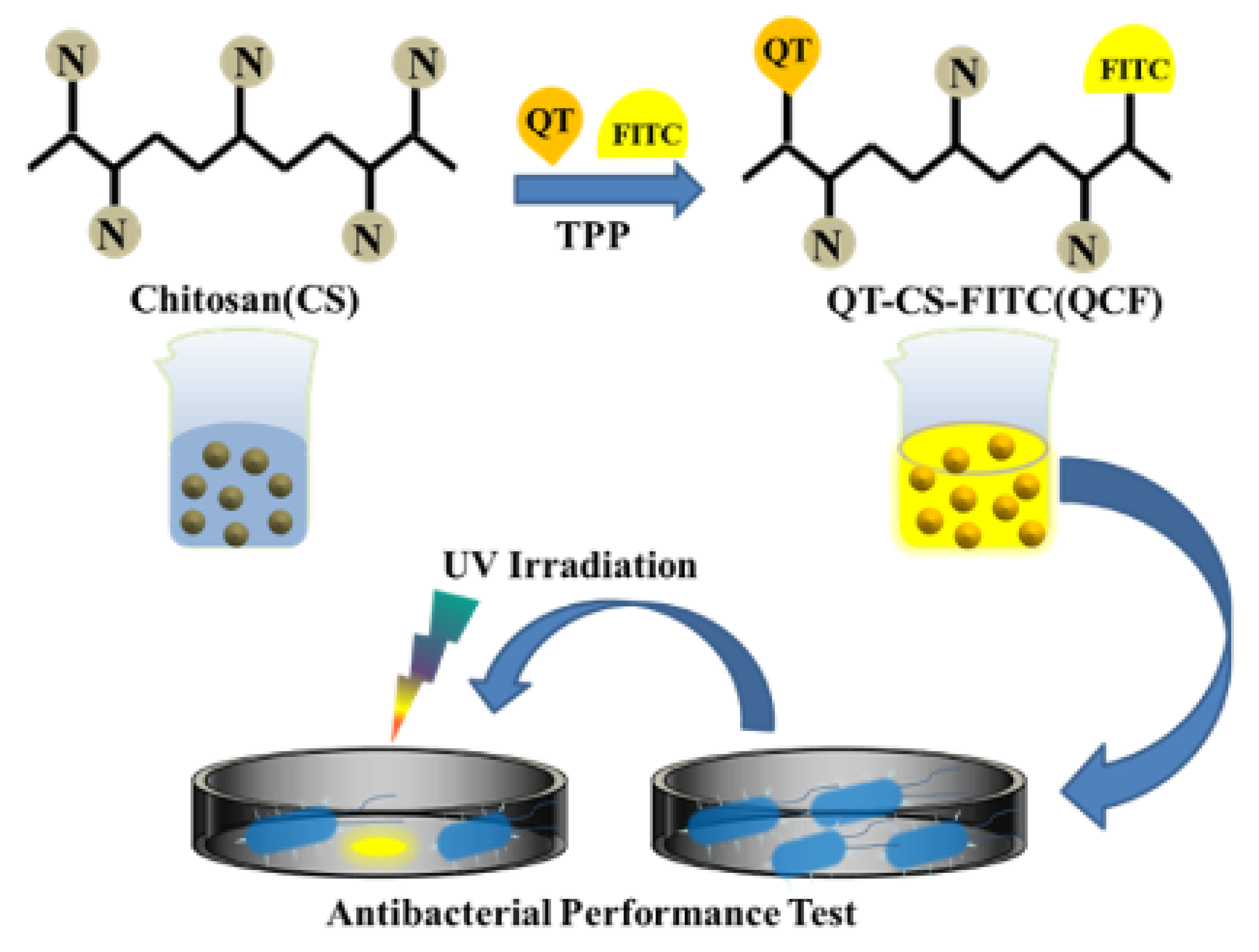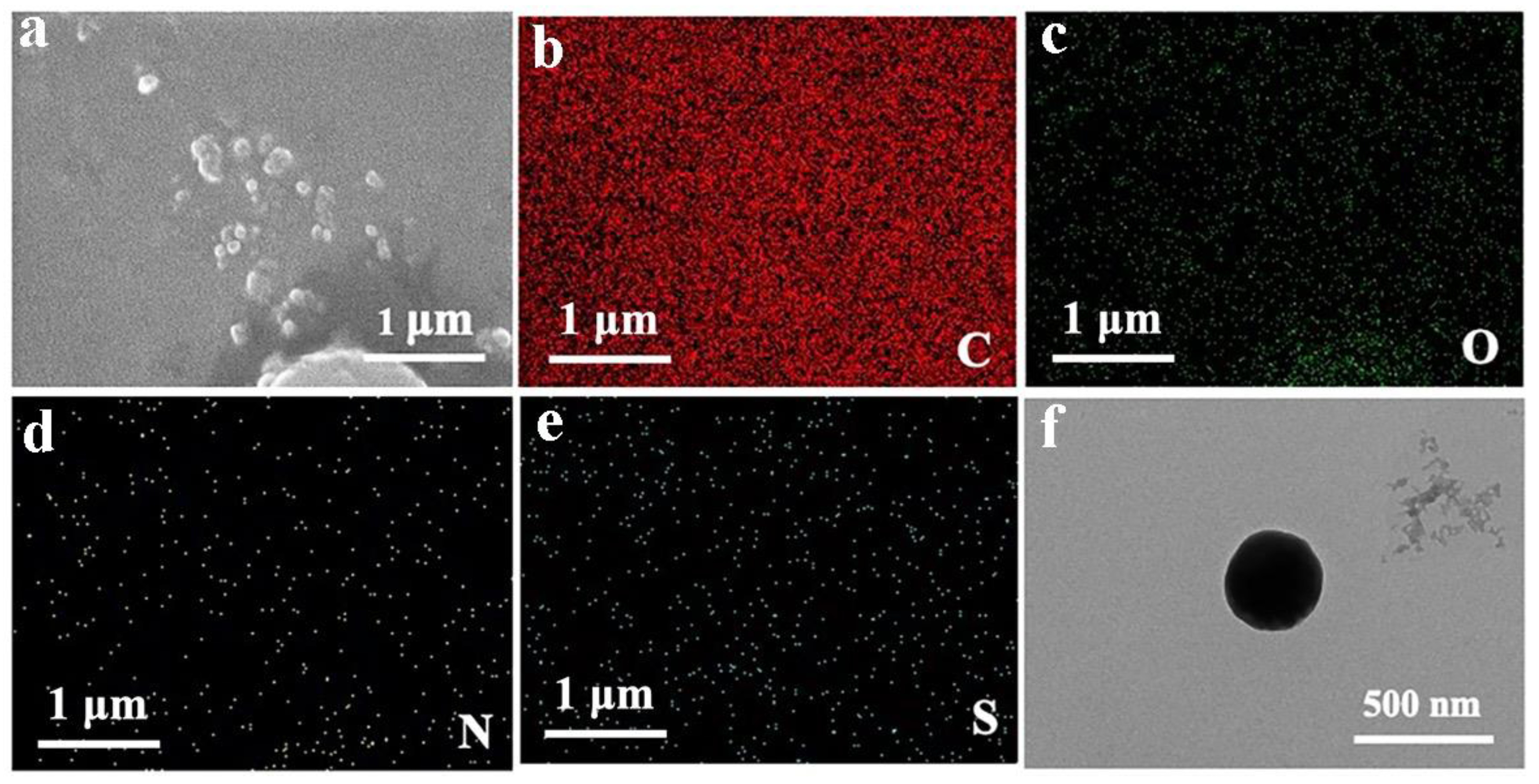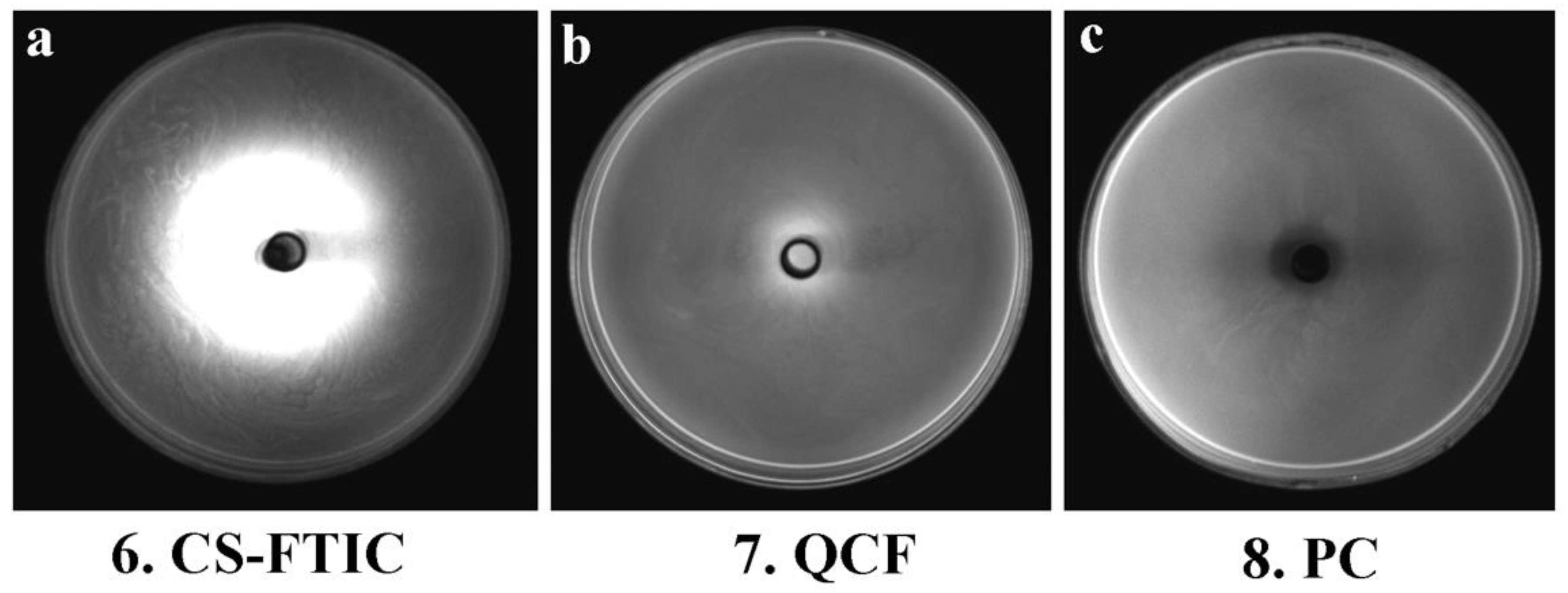Preparation of Fluorescently Labeled Chitosan-Quercetin Drug-Loaded Nanoparticles with Excellent Antibacterial Properties
Abstract
:1. Introduction
2. Materials and Methods
2.1. Materials
2.2. Preparation of Chitosan-Quercetin Drug-Loaded Nanoparticles
2.3. Preparation of Fluorescence-Labeled Chitosan-Quercetin Drug-Loaded Nanoparticles
2.4. The Rate of Drug-Loaded and Encapsulation Testing
2.5. Antioxidant Performance of QC
2.6. Antimicrobial Resistance Testing
2.7. Characterization
3. Results and Discussion
3.1. Performance Analysis of Chitosan-Quercetin Drug-Loaded Microspheres (QC)
3.2. Performance Analysis of Quercetin-Chitosan-Fluorescein Isothiocyanate (QCF)
4. Conclusions
Author Contributions
Funding
Institutional Review Board Statement
Informed Consent Statement
Data Availability Statement
Conflicts of Interest
References
- Tabani, H.; Alexovi, M.; Sabo, J.; Payán, M.R. An overview on the recent applications of agarose as a green biopolymer in micro-extraction-based sample preparation techniques. Talanta 2020, 224, 121892. [Google Scholar] [CrossRef] [PubMed]
- Rabey, H.A.; Almutairi, F.M.; Alalawy, A.I.; Al-Duais, M.A.; Sakran, M.I.; Zidan, N.S.; Tayel, A.A. Augmented control of drug-resistant Candida spp. via fluconazole loading into fungal Chitosan nanoparticles. Int. J. Biol. Macromol. 2019, 141, 511–516. [Google Scholar] [CrossRef] [PubMed]
- Dash, M.; Ottenbrite, R.M.; Chiellini, F. Chitosan-A versatile semi-synthetic polymer in biomedical applications. Prog. Polym. Sci. 2011, 36, 981–1014. [Google Scholar] [CrossRef]
- Mutharani, B.; Ranganathan, P.; Chen, S.M. Chitosan-gold collapse gel/poly (bromophenol blue) redox-active film. A perspective for selective electrochemical sensing of flutamide. Int. J. Biol. Macromol. 2018, 124, 759–770. [Google Scholar] [CrossRef] [PubMed]
- Gratieri, T.; Gelfuso, G.M.; Freitas, O.D.; Rocha, E.M.; Lopez, R.F. Enhancing and sustaining the topical ocular delivery of fluconazole using Chitosan solution and poloxamer/Chitosan in situ forming gel. Eur. J. Pharm. Biopharm. 2011, 79, 320–327. [Google Scholar] [CrossRef] [PubMed]
- Işıklan, N.; Erol, Ü.H. Design and evaluation of temperature-responsive Chitosan/hydroxypropyl cellulose blend nanospheres for sustainable flurbiprofen release. Int. J. Biol. Macromol. 2020, 159, 751–762. [Google Scholar] [CrossRef]
- Egil, A.C.; Ozdemir, B.; Gunduz, S.K.; Altıkatoglu-Yapaoz, M.; Budama-Kilinc, Y.; Mostafavi, E. Chitosan/calcium nanoparticles as advanced antimicrobial coating for paper documents. Int. J. Biol. Macromol. 2022, 215, 521–530. [Google Scholar] [CrossRef]
- Wang, X.; Hu, Y.L.; Zhang, Z.; Zhang, B.J. The application of thymol-loaded chitosan nanoparticles to control the biodeterioration of cultural heritage sites. J. Cult. Herit. 2022, 53, 206–211. [Google Scholar] [CrossRef]
- Shinde, U.A.; Joshi, P.N.; Jain, D.D.; Singh, K. Preparation and Evaluation of N-Trimethyl Chitosan Nanoparticles of Flurbiprofen for Ocular Delivery. Curr. Eye Res. 2019, 44, 575–582. [Google Scholar] [CrossRef]
- Zhao, K.; Shi, X.; Zhao, Y.; Wei, H.X.; Sun, Q.S.; Huang, T.T.; Zhang, X.Y.; Wang, Y.F. Preparation and immunological effectiveness of a swine influenza DNA vaccine encapsulated in Chitosan nanoparticles. Vaccine 2011, 29, 8549–8556. [Google Scholar] [CrossRef]
- Ainali, N.M.; Xanthopoulou, E.; Michailidou, G.; Zamboulis, A.; Bikiaris, D.N. Microencapsulation of Fluticasone Propionate and Salmeterol Xinafoate in Modified Chitosan Microparticles for Release Optimization. Molecules 2020, 25, 3888. [Google Scholar] [CrossRef]
- Zheng, Y.Z.; Deng, G.; Liang, Q.; Chen, D.F.; Guo, R.; Lai, R.C. Antioxidant Activity of Quercetin and Its Glucosides from Propolis: A Theoretical Study. Sci. Rep. 2017, 7, 237–240. [Google Scholar] [CrossRef]
- Smith, A.J.; Kavuru, P.; Wojtas, L.; Zaworotko, M.J.; Shytle, R.D. Cocrystals of Quercetin with improved solubility and oral bioavailability. Mol. Pharm. 2011, 8, 1867–1876. [Google Scholar] [CrossRef]
- Fan, M.; Zhang, G.; Hu, X.; Xu, X.; Gong, D. Quercetin as a tyrosinase inhibitor: Inhibitory activity, conformational change and mechanism. Food Res. Int. 2017, 100, 226–233. [Google Scholar] [CrossRef]
- Xu, D.; Hu, M.J.; Wang, Y.Q.; Cui, Y.L. Antioxidant Activities of Quercetin and Its Complexes for Medicinal Application. Molecules 2019, 24, 1123. [Google Scholar] [CrossRef]
- Kyuichi, K.; Rie, M.; Akari, I. Quercetin and related polyphenols: New insights and implications for their bioactivity and bioavailability. Food Funct. 2015, 6, 1399–1417. [Google Scholar]
- Wang, W.Y.; Sun, C.X.; Mao, L.K.; Ma, P.H.; Liu, F.G.; Yang, J.; Gao, Y.X. The biological activities, chemical stability, metabolism and delivery systems of Quercetin: A review. Trends Food Sci. Tech. 2016, 56, 21–38. [Google Scholar] [CrossRef]
- Tang, S.M.; Deng, X.T.; Zhou, J.; Li, Q.P.; Ge, X.X.; Miao, L. Pharmacological basis and new insights of Quercetin action in respect to its anti-cancer effects. Biomed. Pharmacother. 2020, 121, 109604. [Google Scholar] [CrossRef]
- Andrea, G.D. Quercetin: A flavonol with multifaceted therapeutic applications. Fitoterapia 2015, 106, 256–271. [Google Scholar] [CrossRef]
- Li, H.; Wang, D.; Liu, C.; Zhu, J.; Fan, M.; Sun, X.; Wang, T.; Xu, Y.; Cao, Y. Fabrication of stable zein nanoparticles coated with soluble soybean polysaccharide for encapsulation of Quercetin. Food Hydrocoll. 2019, 87, 342–351. [Google Scholar] [CrossRef]
- Wang, H.; Yang, Z.M.; He, Z.Y.; Zhou, C.; Wang, C.; Li, P.W. Preparation and Physicochemical Properties of Amphiphilic Chitosan/Quercetin nanomicelles. Chin. J. Trop. Crops 2019, 40, 980–986. [Google Scholar]
- Aluani, D.; Tzankova, V.; Kondeva-Burdina, M.; Yordanov, Y.; Nikolova, E.; Odzhakov, F.; Apostolov, A.; Markova, T.; Yoncheva, K. Evaluation of biocompatibility and antioxidant efficiency of chitosan-alginate nanoparticles loaded with quercetin. Int. J. Biol. Macromol. 2017, 103, 771–782. [Google Scholar] [CrossRef] [PubMed]
- He, X.H.; Hu, L.Q.; Zou, L.S.; Zhong, J.C.; Luo, H.; Pu, Z.J. Enhanced fluorescence properties of flexible waterborne polyurethane films by blocking FITC (FITC). Mater. Lett. 2021, 293, 129668. [Google Scholar] [CrossRef]
- Li, H.; Jiang, Z.W.; Han, B.Q.; Niu, S.Y.; Dong, W.; Liu, W.S. Pharmacokinetics and Biodegradation of Chitosan in Rats. J. Ocean. Univ. China 2015, 14, 897–904. [Google Scholar] [CrossRef]
- Liu, Z.W.; Li, N.; Liu, P.; Qin, Z.H.; Jiao, T.F. Highly sensitive detection of iron ions in aqueous solutions using fluorescent chitosan nanoparticles functionalized by rhodamine B. ACS Omega 2022, 7, 5570–5577. [Google Scholar] [CrossRef]
- Li, X.C. Improved pyrogallol autoxidation method: A reliable and cheap superoxide-scavenging assay suitable for all antioxidants. J. Agric. Food Chem. 2012, 60, 6418–6424. [Google Scholar] [CrossRef]
- DiSilvestro, R.A.; DiSilvestro, D.J.; Joseph, E. Assay of Superoxide Dismutase 1 Activity: Comparison of Two Commercial Assay Kits with a Modified Pyrogallol Autoxidation Method. FASEB J. 2007, 21, 814. [Google Scholar]
- Jiayun, D.; Jiabin, L.; Qiusheng, Y.; Jisheng, P. Basic Research on Chemical Mechanical Polishing of Single-crystal SiC-Electro-Fenton: Reaction Mechanism and Modelling of Hydroxyl Radical Generation Using Condition Response Modelling. J. Environ. Chem. Eng. 2020, 9, 104954. [Google Scholar]
- Ahile, U.J.; Wuana, R.A.; Itodo, A.U.; Sha’Ato, R.; Dantas, R.F. Stability of iron chelates during photo-Fenton process: The role of pH, hydroxyl radical attack and temperature. J. Water Process Eng. 2020, 36, 101320. [Google Scholar] [CrossRef]
- Wen, Y.; Yao, F.L.; Sun, F.; Tan, Z.L.; Tian, L.; Xie, L.; Song, Q.C. Antibacterial action mode of quaternized carboxymethyl chitosan/poly (amidoamine) dendrimer core-shell nanoparticles against E. coli correlated with molecular chain conformation. Mater. Sci. Eng. C 2015, 48, 220–227. [Google Scholar] [CrossRef]
- Khalil, K.D.; Ibrahim, E.I.; Al-Sagheer, F.A. Synthesis of chitosan-graft-poly [2-cyano-1-(pyridin-3-yl) allyl acrylate] copolymer from a novel monomer, prepared using a Morita-Baylis-Hillman reaction and characterization of its antimicrobial activity. Polym. Int. 2014, 63, 2042–2051. [Google Scholar] [CrossRef]
- Tokura, S.; Ueno, K.; Miyazaki, S.; Nishi, N. Molecular Weight Dependent Antimicrobial Activity by Chitosan. In New Macromolecular Architecture and Functions; Springer: Berlin/Heidelberg, Germany, 1996; pp. 199–207. [Google Scholar]
- Liu, X.F.; Guan, Y.L.; Yang, D.Z.; Li, Z.; Yao, K.D. Antibacterial action of chitosan and carboxymethylated chitosan. J. Appl. Polym. Sci. 2001, 79, 1324–1335. [Google Scholar]
- Li, H.; Peng, L. Antimicrobial and antioxidant surface modification of cellulose fibers using layer-by-layer deposition of chitosan and lignosulfonates. Carbohydr. Polym. 2015, 124, 35–42. [Google Scholar] [CrossRef]
- Zhang, Y.; Wu, Y.T.; Zheng, W.; Han, X.X.; Jiang, Y.H.; Hu, P.L.; Tang, Z.X.; Shi, L.E. The antibacterial activity and antibacterial mechanism of a polysaccharide from Cordyceps cicadae. J. Funct. Foods 2017, 38, 273–279. [Google Scholar] [CrossRef]
- Li, Z.; Deng, H.; Zhou, Y.; Tan, Y.; Zhi, F. Bioluminescence Imaging to Track Bacteroides fragilis Inhibition of Vibrio parahaemolyticus Infection in Mice. Front. Cell. Infect. Microbiol. 2017, 7, 170. [Google Scholar] [CrossRef] [Green Version]
- Asghar, M.A.; Asghar, M.A. Green synthesized and characterized copper nanoparticles using various new plants extracts aggravate microbial cell membrane damage after interaction with lipopolysaccharide. Int. J. Biol. Macromol. 2020, 160, 1168–1176. [Google Scholar] [CrossRef]
- Tian, T.; Sun, B.; Shi, H.; Gao, T.; He, Y.; Li, Y.; Liu, Y.; Li, X.X.; Zhang, L.Q.; Li, S.D.; et al. Sucrose triggers a novel signaling cascade promoting Bacillus subtilis rhizosphere colonization. ISME J. 2021, 15, 2723–2737. [Google Scholar] [CrossRef]
- Xue, H.Y.; Zhang, Y.; Zhang, B.Y.; Xue, L.H. Preparation characterization and bacteriostatic properties of punicalagin reducing Chitosan/nano silver sol. Trans. Chin. Soc. Agric. Eng. 2018, 34, 306–314. [Google Scholar]
- Wang, X.W.; Cheng, F.Y.; Wang, X.J.; Feng, T.T.; Xia, S.Q.; Zhang, X.M. Chitosan decoration improves the rapid and long-term antibacterial activities of cinnamaldehyde-loaded liposomes. Int. J. Biol. Macromol. 2021, 168, 59–66. [Google Scholar] [CrossRef]
- Li, J.H.; Wu, Y.G.; Zhao, L.Q. Antibacterial activity and mechanism of Chitosan with ultra high molecular weight. Carbohydr. Polym. 2016, 148, 200–205. [Google Scholar] [CrossRef]
- Arkoun, M.; Daigle, F.; Heuzey, M.C.; Ajji, A.; Vasilev, K. Mechanism of Action of Electrospun Chitosan-Based Nanofibers against Meat Spoilage and Pathogenic Bacteria. Molecules 2017, 22, 585. [Google Scholar] [CrossRef]
- Wang, S.G.; Yao, J.Y.; Zhou, B.; Yang, J.X.; Chaudry, M.T.; Wang, M.; Xiao, F.L.; Li, Y.; Yin, W.Z. Bacteriostatic Effect of Quercetin as an Antibiotic Alternative In Vivo and Its Antibacterial Mechanism In Vitro. J. Food Prot. 2018, 81, 68–78. [Google Scholar] [CrossRef]
- Zhang, H.; Feng, J.; Zhu, W.; Liu, C.; Gu, J. Bacteriostatic effects of cerium-humic acid complex: An experimental study. Biol. Trace Elem. Res. 2000, 73, 29–36. [Google Scholar] [CrossRef]
- Chen, Q.; Fei, P.; Hu, Y. Hierarchical mesopore wood filter membranes decorated with silver nanoparticles for straight-forward water purification. Cellulose 2019, 26, 8037–8046. [Google Scholar] [CrossRef]
- Zhao, W.; Zhang, R.R.; Ma, C.X.; Qiu, M.Y.; Gong, P.H.; Liu, Y.T.; Shao, S.; Yan, M.M.; Zhao, D.Q. Study on the wound healing, anti-inflammation and anti-bacterial activities of Jinjianling cream: A Chinese herbal compound. Pak. J. Pharm. Sci. 2019, 32, 1361–1370. [Google Scholar]
- Zeng, A.; Wang, Y.; Li, D.; Guo, J.; Chen, Q. Preparation and antibacterial properties of polycaprolactone/quaternized chitosan blends. Chin. J. Chem. Eng. 2021, 32, 462–471. [Google Scholar] [CrossRef]
- Chen, Q.; Jiang, H.; Ye, H.; Li, J.; Huang, J. Preparation, antibacterial, and antioxidant activities of silver/chitosan composites. J. Carbohydr. Chem. 2014, 33, 298–312. [Google Scholar] [CrossRef]
- Qian, J.; Pan, C.; Liang, C. Antimicrobial activity of Fe-loaded chitosan nanoparticles. Eng. Life Sci. 2017, 17, 629–634. [Google Scholar] [CrossRef]
- Tamara, F.R.; Lin, C.; Mi, F.L.; Ho, Y.C. Antibacterial effects of chitosan/cationic peptide nanoparticles. Nanomaterials 2018, 8, 88. [Google Scholar] [CrossRef]
- Wu, T.; Wu, C.; Fu, S.; Wang, L.; Yuan, C.; Chen, S.; Hu, Y. Integration of lysozyme into chitosan nanoparticles for improving antibacterial activity. Carbohydr. Polym. 2017, 155, 192–200. [Google Scholar] [CrossRef]
- Ali, M.J.; Sharafaldin, A.M.; Majid, P.; Mahdi, F.R.; Kazem, A.; Hajar, R.; Zuhair, M.H.; Mahdi, K.M.; Reza, M. Curcumin-loaded chitosan tripolyphosphate nanoparticles as a safe, natural and effective antibiotic inhibits the infection of Staphylococcus aureus and Pseudomonas aeruginosa In Vivo. Iran. J. Biotechnol. 2014, 12, 1–8. [Google Scholar]








| Volume Ratio | pH | Ab | DL (%) | EE (%) |
|---|---|---|---|---|
| 1:1 | 6.20 | 3.33 | 6.79 | 73.1 |
| 2:1 | 5.78 | 1.49 | 7.26 | 81.9 |
| 3:1 | 5.65 | 1.06 | 7.92 | 82.3 |
| 4:1 | 5.46 | 0.629 | 8.15 | 82.4 |
| 5:1 | 5.45 | 0.618 | 8.39 | 83.7 |
| 6:1 | 5.43 | 0.555 | 8.04 | 82.4 |
| 7:1 | 5.40 | 0.527 | 7.89 | 82.6 |
| 8:1 | 5.37 | 0.502 | 7.01 | 82.1 |
| Diameter o Bacteriostatic Circle (mm) | Experimental Result |
|---|---|
| ≤8 | not sensitive |
| 8 < d < 10 | low sensitivity |
| 10 ≤ d < 15 | moderately sensitive |
| 15 ≤ d < 20 | highly sensitive |
| ≥20 | extremely sensitive |
| Sample | Diameter of Bacteriostatic Circle (mm) | Sensitivity |
|---|---|---|
| 1 | 8 | not sensitive |
| 2 | 8 | not sensitive |
| 3 | 12 | moderately sensitive |
| 4 | 14 | moderately sensitive |
| 5 | 12 | moderately sensitive |
| 6 | 8 | not sensitive |
| 7 | 12 | moderately sensitive |
| 8 | 17 | highly sensitive |
| Loaded Nanoparticles | Fluorescent Probes | Bacteria | Ref. |
|---|---|---|---|
| Chitosan-quercetin | fluorescein isothiocyanate | E. coli | This work |
| polycaprolactone/quaternized chitosan | - | E. coli | [47] |
| chitosan/pectin-based silver nanoparticle films | - | E. coli | [48] |
| CS–Cu2+ nanoparticle | - | E. coli, Staphylococcus aureus, Candida albicans | [49] |
| chitosan/protamine hybrid nanoparticles | - | E. coli | [50] |
| chitosan–lysozyme nanoparticles | - | E. coli | [51] |
| Curcumin-loaded Chitosan Tripolyphosphate Nanoparticles | - | Staphylococcus aureus | [52] |
Publisher’s Note: MDPI stays neutral with regard to jurisdictional claims in published maps and institutional affiliations. |
© 2022 by the authors. Licensee MDPI, Basel, Switzerland. This article is an open access article distributed under the terms and conditions of the Creative Commons Attribution (CC BY) license (https://creativecommons.org/licenses/by/4.0/).
Share and Cite
Zhou, J.; Li, N.; Liu, P.; Liu, Z.; Gao, L.; Jiao, T. Preparation of Fluorescently Labeled Chitosan-Quercetin Drug-Loaded Nanoparticles with Excellent Antibacterial Properties. J. Funct. Biomater. 2022, 13, 141. https://doi.org/10.3390/jfb13030141
Zhou J, Li N, Liu P, Liu Z, Gao L, Jiao T. Preparation of Fluorescently Labeled Chitosan-Quercetin Drug-Loaded Nanoparticles with Excellent Antibacterial Properties. Journal of Functional Biomaterials. 2022; 13(3):141. https://doi.org/10.3390/jfb13030141
Chicago/Turabian StyleZhou, Jingxin, Na Li, Ping Liu, Zhiwei Liu, Lili Gao, and Tifeng Jiao. 2022. "Preparation of Fluorescently Labeled Chitosan-Quercetin Drug-Loaded Nanoparticles with Excellent Antibacterial Properties" Journal of Functional Biomaterials 13, no. 3: 141. https://doi.org/10.3390/jfb13030141





